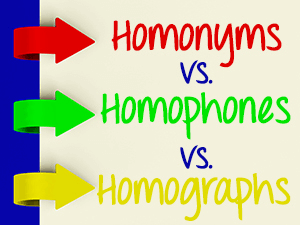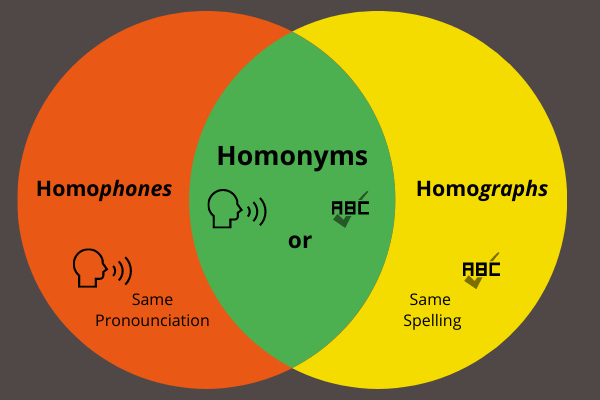Difference Between Homophones and HomonymsHomophones and homonyms are commonly used as interchangeable words but have distinct linguistic meanings. This article tries to clarify the distinctiveness between homophones and homonyms and offers both instances. 
Homophones refer to terms that share a similar sound but differ in their spellings and meanings. The prefix "homo-" means "same," while "-phone" means "sound." As a result, homophones refer to words with similar sounds but distinct spellings and meanings. Examples of Homophones Include
Homophones can sometimes be tricky for English language learners to distinguish, as they sound very similar. However, context can often help in determining the correct word. HomonymsHomonyms share the exact spelling and pronunciation yet have distinct meanings. The prefix "homo-" means "same," while "-nym" means "name." Therefore, homonyms are words with the same name but different meanings. Examples of Homonyms Include:
Homonyms can be confusing, as they have the exact spelling and pronunciation. However, their meanings are usually different enough that context can help determine the intended purpose. HomographsA third term is sometimes used in conjunction with homophones and homonyms, which is homographs. Homographs are terms spoken the same but have distinct meanings and pronunciations. Examples of Homographs Include
Homographs can be even more confusing than homophones and homonyms, as they can have different pronunciations depending on the context in which they are used. Distinguishing Between Homophones and Homonyms
To distinguish between homophones and homonyms, one must pay attention to the spelling and meaning of the words. Homophones are words that sound alike but are spelled differently and have distinct meanings. In contrast, homonyms are words that have the same spelling and pronunciation but different meanings. For instance, "flower" and "flour" are homophones because they sound the same but have different spellings and meanings. Conversely, the words "bat" (an animal) and "bat" (an object used in sports) are homonyms because they have the same spelling and pronunciation but different meanings. When distinguishing between homophones and homonyms, it is crucial to consider the context in which they are used. In some cases, the meaning of a word may be uncertain based on the context. Differences in the Tabular Form
ConclusionHomophones and Homonyms are two linguistic concepts that are often confused but refer to different things. Homophones are words that have the same pronunciation but different meanings and spellings. Homonyms are words that have the same spelling and pronunciation but different meanings. While homophones and homonyms can be confusing, they are important to the English language. Understanding these two concepts' differences can help improve communication and prevent misunderstandings. Homophones are often used in wordplay, poetry, and jokes because of their similar sound and different meanings. On the other hand, homonyms can often confuse context, especially if the sentence's context is unclear. For example, if someone says, "I went to the bank to deposit my money," it may not be clear whether they are referring to a financial institution or the side of a river. Similarly, if someone says, "I saw a bat in the park," it may not be clear whether they are referring to the animal or the sports equipment. Understanding the differences between these two types of words is important for effective communication in the English language.
Next TopicDifference Between
|
 For Videos Join Our Youtube Channel: Join Now
For Videos Join Our Youtube Channel: Join Now
Feedback
- Send your Feedback to [email protected]
Help Others, Please Share










